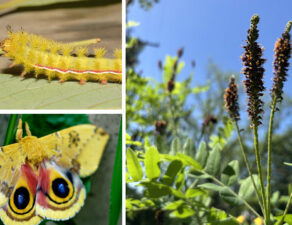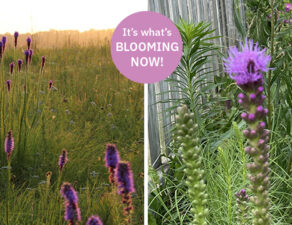
Pictured: Left: Common Milkweed; Right: Butterfly Milkweed
Butterfly Milkweed (Asclepias tuberosa) and Common Milkweed (Asclepias syriaca)
In Nature
Prairie birthdays begin this time of year. You can visit the same location every day and a new native plant opens to greet the world. Asclepias species like Butterfly Milkweed and Common Milkweed are two of many that can be found in nature. Like cousins, they share similarities but are their own individuals. As the common name implies, the bright orange flowers of Butterfly Milkweed are attractive nectaring sites for Great Spangled Fritillary butterflies. All Asclepias are larval host plants for the Monarch butterfly. Carefully look for a single egg laid on the underside of a leaf and caterpillars. Small but mighty, you can find Butterfly Milkweed tucked around other plants like Leadplant (Amorpha canadense) and Pale purple coneflower (Echinacea pallida) on the prairie.
In Gardens
With its tropical foliage, upright habit, fuzzy buds, and sculptural flowers, the stunning Asclepias syriaca is horribly slandered by the monicker Common Milkweed. There is certainly nothing common or weedy about its enormous, fragrant, disco ball blooms.
This beautiful plant is also highly valuable. While we all know that Milkweed is the one genus capable of supporting Monarch caterpillars, studies have found that two particular species — Common Milkweed (Asclepias syriaca) and Swamp Milkweed (Asclepias incarnata) are more sought after by female Monarchs, who lay far more eggs on these two when given a choice of Milkweed species. Further studies have discovered the reason: eggs laid on Common Milkweed and Swamp Milkweed have a higher rate of success to adulthood. Mom knows best!
The “common” part of the Common Milkweed appellation originally came from its ubiquity in the wild. But due to rampant development and thoughtless mowing of highway verges, Common Milkweed is no longer at all common. In fact, surveys estimate a loss of more than a third of the Midwest’s milkweed stock from 1999-2014, with even greater losses in the decade since.
Happily, both Common Milkweed and Swamp Milkweed grow very well in Kansas City gardens. Common Milkweed is especially adaptable, not only thriving in our hard, dry clay, but also generously spreading itself into the large stands needed by Monarch caterpillars. It is that robustness and generosity that has earned it an unfair reputation for being “aggressive” and “too vigorous and weedy for borders.”
Good thing that doesn’t deter our Habitat Garden Hosts. In May, part of the surprise in “Sunset Surprise” was Susan’s fearless use of Common Milkweed: not only in the long driveway strip amidst other hearty species like Goldenrods and Asters, but also in her front showcase, alongside delicate Blue Star Amsonia.
Our June 8th gardens also grow Common Milkweed in wonderful ways. In Karen G’s Wildlife Refuge, Common Milkweed thrives with Elderberry and Wild Strawberry. By allowing it to stay wherever it pops up, Karen has found it adaptable to a surprising amount of shade. The Monarchs, meanwhile, appreciate its proximity to her backyard pond.
The centerpiece of Talis’s garden is an enclosed bed displaying some of the former Peony Society President’s most treasured peonies. But the outer edge of this enclosure is devoted to a large bed of Common Milkweed, which has also spread itself into a border fronting the artist studio. Still more has been transplanted into a new bed of native glade and prairie plants, where it looks every bit as ornamental as its neighbors.
GET TO KNOW BUTTERFLY MILKWEED:
Light Requirements: full sun
Soil Moisture: dry to medium
Soil Description: tolerates dry soil and shallow-rocky soil
Height: 1′ to 2.5′
Bloom Time: June – August
Bloom Color: orange to yellow-orange
GET TO KNOW COMMON MILKWEED:
Light Requirements: full sun
Soil Moisture: dry to medium
Soil Description: adaptable – tolerates clay, poor or shallow-rocky soil
Height: 2′ to 4′
Bloom Time: June – August
Bloom Color: pink, mauve, white





